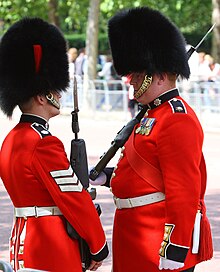Lance sergeant
Lance sergeant (LSgt or L/Sgt) is an appointment in the armies of the Commonwealth and formerly also a rank in the United States Army.

Commonwealth
Lance-sergeant in the armies of the Commonwealth was an appointment given to a corporal so they could fill a post usually held by a sergeant. The appointment is retained now only in the Foot Guards and Honourable Artillery Company in the British Army. In these regiments today, all corporals are automatically appointed lance sergeant on their promotion, so lance sergeants perform the same duties as corporals in other regiments and are not acting in place of sergeants. The Household Cavalry equivalent is lance-corporal of horse.
The appointment originated in the British Army and Royal Marines, in which it could be removed by the soldier's commanding officer, unlike a full sergeant, who could only be demoted by court martial.[citation needed] Lance-sergeants first appeared in the 19th century.[a] The appointment was abolished in most regiments and corps in 1946.[citation needed] Some cadet units also retained the rank in addition to corporal into at least the 1980s.[citation needed]
Lance sergeants wear three rank chevrons, the same insignia as a sergeant. In full dress, Foot Guards lance sergeants are distinguished from full sergeants by their white chevrons (full sergeants wearing gold); and in working dress, primarily by wearing an other ranks cap badge instead of a senior NCO variant.
Some sources claim that the use of the appointment of lance-sergeant was introduced by Queen Victoria, who stated that her guards would not wear only one chevron when mounting guard outside the royal palaces. Guards lance-corporals therefore wore (and still wear) two chevrons. That left the problem of what the full corporal would wear, so the appointment of lance-sergeant was introduced.[2] However, the Guards regiments still had corporals until after the First World War and the appointment of lance-sergeant was used throughout the army (not just by the Guards) until 1946,[citation needed] so the veracity of the story is questionable.
United States
The rank of lance sergeant existed in the U.S. Army from at least 1841 until sometime between 1901 and 1904. The first official documentation for the rank appears in General Regulations for the Army of the United States (Article XVI, Paragraph 64), published on 25 January 1841. The last recorded reference to the lance sergeant rank was in Regulations for the Army of the United States 1895, With Appendix Separately Indexed and Showing Changes to January 1, 1901 (Article XXXII, Paragraph 257). In Regulations for the Army of the United States 1904, the rank of lance sergeant does not appear and it does not appear in further iterations of U.S. Army regulations.[b]
Footnotes
- ^ The earliest mentions of the appointment in the London Gazette and The Times are actually in connection with the Royal Marines in 1840.[1]
- ^ None of the referenced regulations provide any information pertaining to the prerequisites for appointment to lance sergeant, or the rank insignia, manning authorisation, duties, responsibilities, or authority of the lance sergeant.
- ^ "No. 19904". The London Gazette. 13 October 1840. p. 2254.; "General Court-Martial at Woolwich", The Times, 2 June 1840.
- ^ "The Irish Guards, Badges of Rank". Archived from the original on 2003-07-28. Retrieved 2009-05-09.
